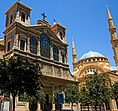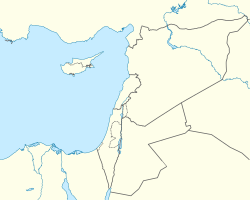
Back Bairut ACE Beiroet Afrikaans Beirut ALS ቤይሩት Amharic Beirut AN Berytus ANG بيروت Arabic ܒܝܪܘܬ ARC بيروت ARY بيروت ARZ
Beirut
بيروت | |
|---|---|
Left to right from top: Beirut Zaitunay Bay; Sahat al Shouhada; The Clock Tower in Nejmeh Square, Beirut; Maronite Cathedral of Saint George (left) and Mohammad Al-Amin Mosque (right); Sursock Museum; and Pigeon Rocks of Raouché | |
| Nickname: Paris of the East[1] | |
| Motto(s): | |
| Coordinates: 33°53′53″N 35°30′21″E / 33.89806°N 35.50583°E | |
| Country | |
| Governorate | Beirut |
| Government | |
| • Governor | Marwan Abboud |
| • Mayor | Abdallah Darwish |
| Area | |
• Capital city and municipality | 21.25 km2 (8.20 sq mi) |
| Population | |
• Capital city and municipality | c. 433,249 |
| • Metro | c. 2,145,527 |
| Demonym | Beiruti |
| Time zone | UTC+2 (EET) |
| • Summer (DST) | UTC+3 (EEST) |
| Area code | +961 (01) |
| ISO 3166 code | LB-BA |
| Patron Saint | Saint George |
| Website | www |
Beirut (/beɪˈruːt/ bay-ROOT;[4] Arabic: بيروت, romanized: ) is the capital and largest city of Lebanon. As of 2014[update], Greater Beirut has a population of 2.5 million, just under half of Lebanon's population,[5] which makes it the fourth-largest city in the Levant region and the sixteenth-largest in the Arab world. The city is situated on a peninsula at the midpoint of Lebanon's Mediterranean coast. Beirut has been inhabited for more than 5,000 years, making it one of the oldest cities in the world.
Beirut is Lebanon's seat of government and plays a central role in the Lebanese economy, with many banks and corporations based in the city. Beirut is an important seaport for the country and region, and rated a Beta + World City by the Globalization and World Cities Research Network.[6] Beirut was severely damaged by the Lebanese Civil War, the 2006 Lebanon War, and the 2020 massive explosion in the Port of Beirut. Its architectural and demographic structure underwent major change in recent decades.[7][8][9][10]
- ^ Cooke, Rachel (22 November 2006). "Paris of the east? More like Athens on speed". The Guardian. Archived from the original on 7 November 2022. Retrieved 8 March 2017.
- ^ a b "Lebanon: Administrative Division (Governorates and Districts) - Population Statistics, Charts and Map". Archived from the original on 2 July 2021. Retrieved 1 July 2022.
- ^ "Beirut City Profile 2021" (PDF). unhabitat.org. United Nations Human Settlements Programme. Retrieved 16 November 2024.
- ^ Jones, Daniel (2011). Roach, Peter; Setter, Jane; Esling, John (eds.). Cambridge English Pronouncing Dictionary (18th ed.). Cambridge University Press. ISBN 978-0-521-15255-6.
- ^ "Questions & Answers: Water Supply Augmentation Project, Lebanon Archived 28 May 2019 at the Wayback Machine". The World Bank. 30 September 2016. Retrieved 20 March 2016.
- ^ "The World According to GaWC 2020". GaWC – Research Network. Globalization and World Cities. Archived from the original on 24 August 2020. Retrieved 31 August 2020.
- ^ Reconstruction of Beirut Archived 16 January 2009 at the Wayback Machine, Macalester College
- ^ Lebanon's Reconstruction: A Work in Progress, VOA News
- ^ "Beirut: Between Memory And Desire". Worldview. Archived from the original on 3 March 2016.
- ^ Antelava, Natalia (10 May 2010). "'Ugly Beirut' struggles to survive peace". BBC News. Archived from the original on 5 August 2023. Retrieved 5 August 2023.










